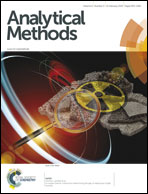l-Cysteine/glycine composite film modified glassy carbon electrode as an enhanced sensing platform for catechol determination
Abstract
In this report, a novel voltammetric sensor based on a glassy carbon electrode modified with L-cysteine/glycine composite film (L-cysteine/glycine/GCE) was developed for the quantitative detection of catechol. The as-fabricated electrode exhibited good electrochemical performance with low electron transfer resistance. The results of electrochemical impedance spectroscopy revealed that electron transfer through the L-cysteine/glycine film was more facile than that for the bare GCE. The electrochemical behavior of catechol at the prepared electrode was also investigated by cyclic voltammetry and differential pulse voltammetry . The modified electrode showed excellent electrocatalytic activity towards the oxidation of catechol in NaOH–KH2PO4 buffer solution (pH = 6.0). Under optimum conditions, a linear relationship between the oxidation peak current and concentration of catechol was obtained in the range from 3 μM to 280 μM with a detection limit of 0.32 μM (3σ). An interference and stability study showed that satisfactory detection results were achieved using this electrode. In addition, the proposed method was successfully applied in the determination of catechol in water samples with satisfactory results.


 Please wait while we load your content...
Please wait while we load your content...